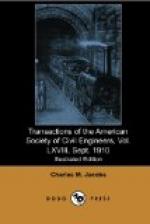In the boiler-room there were three 500-h.p. Sterling water-tube boilers.
(b).—Repair Shops.—The repair shops remained in their old location until sufficient room had been excavated to sub-grade in the lot east of Eighth Avenue, and then they were moved to the old Ninth Avenue power-house which had been erected at that point. The contents of the blacksmith shop remained the same as for the first period. The equipment of the machine shop was increased by one 18-ton trip-hammer operated by air and one bolt-cutting machine, size 1 in. to 11/2 in. The carpenter shop remained the same except that the electric motor was replaced by a 25-h.p. single-cylinder air motor; there was added to the repair shop a drill shop containing: Four forges with compressed air blowers, four anvils, two Ajax 20-ft. drill sharpeners, and one oil blower forge.
2.—Retaining-Wall Plant.
The retaining-wall plant was identical with that described for the first period, with the addition of two Ransome 1-cu. yd., concrete mixers, with vertical engines mounted on the same frame, using compressed air.
3.—Pit-Excavating Plant.
The pit-excavating plant included that listed for the first period and, in addition, the following:
One Vulcan, 30-ton, steam shovel, with
1-cu. yd. dipper and a vertical
boiler.
One Ohio, 30-ton, steam shovel, with 1-cu.
yd. dipper and a vertical
boiler.
Four guy derricks (50 to 80-ft. masts
and 45 to 60-ft. booms),
operated by Lambert 7 by 10-in.
engines, with two drums and swinging
gear, mounted with 25-h.p.
vertical boilers, but driven by
compressed air.
Seventy Ingersoll-Rand rock drills, Nos. 1, 31/4, and 4.
Two Rand quarry bars, cutting 10 ft. in
length at one set-up, and
mounted with No. 4 drill using
a Z-bit.
4.—Transportation Plant.
Twenty-one H. K. Porter locomotives, 10 by 16-in., and 36-in. gauge.
Three Davenport locomotives, 9 by 16-in., and 36-in. gauge.
One hundred and forty Western dump-cars, each of 4 cu. yd. capacity.
One hundred and sixty-five flat cars,
with iron skips, each of 4 cu.
yd. capacity.
5.—Dock Plant.
Four stiff-leg derricks on extension,
having 35-ft. masts and 40-ft.
booms, and each operated by
a 60-h.p. Lambert, three-drum, electric,
hoisting engine.
One stiff-leg derrick, on the south side
of the pier on the upper
deck, with a 28-ft. mast operated
by a three-drum Lambert engine
and a 25-h.p. vertical boiler.
One stiff-leg derrick, on the north side
of the dock on the upper
deck, used exclusively for
bringing in brick, electric conduit,
pipe, and other building material,
operated when first erected by a
three-drum, steam-driven,
Lambert, hoisting engine. This engine was
later changed to the derrick
on the south side of the dock, and a
motor-driven Lambert engine
from that derrick was substituted.




